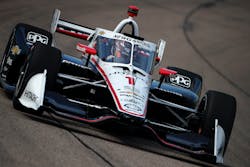Lately additive manufacturing seems to find new ways to save the day – most recently fixing an unanticipated issue for IndyCar. Specifically, IndyCar made a change to the rules for the 2020 season, adding an aeroscreen wrap-around cockpit windscreen. The intent of the aeroscreen is to help protect the driver by deflecting any flying debris away from the driver's helmet. However, in doing so it restricted the cooling air from flowing into the cockpit and around the driver's head. This understandably created a grueling condition for its drivers.
Simply put, something had to change. And, the IndyCar team quickly realized only 3D printing could produce an alternative ahead of the Iowa 250s race within a tight one-week timeframe. IndyCar turned to Stratasys 3D printing technology to develop a new “scoop” to move hot air out of the cockpit.
Stratasys Senior Strategic Applications Engineer Allen Kreemer tells IndustryWeek, part durability was a pleasant surprise for IndyCar. Stratasys used a common grade ASA material often used for general prototyping and mock-ups. However, it also has very good for ductility and flexibility. “For this environment there is a lot of vibration and aerodynamic loading and full sunlight exposure,” he says. “The resulting part will undoubtedly serve as a countermeasure until they can redesign a more permanent molded solution in carbon fiber during the offseason.”





